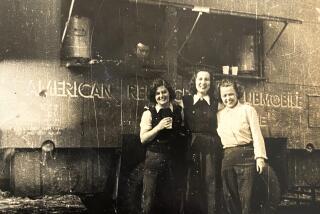NONFICTION : BUSHMASTERS: AMERICA’S JUNGLE WARRIORS OF WORLD WAR II by Anthony Arthur (Thomas Dunne Book/St. Martin’s Press: $18.95; 304 pp., black-and-white photographs).
- Share via
Early one morning in 1945, Gene Uratsu woke up in the Philippines with a bad hangover and a glimpse of terror. Inches from where Uratsu lay in his bunk was the murderous face of a Japanese soldier. With eyes closed again, the American waited for death, but nothing happened. Opening his eyes, he saw the motionless enemy and, with a peculiar feeling of familiarity, he nodded. The Japanese soldier nodded back. Only then did Gene Uratsu realize that he was staring at his own reflection in a mirror.
Uratsu’s moment of terrifying self-reflection as a member of the Bushmasters, the 158th Infantry Regiment, is detailed in Anthony Arthur’s fascinating book. Uratsu’s drinking companions of the night before had nearly as much reason to suspect their own reflections as did the Japanese-American, for his companions were American Indians, whose own physical similarity to the enemy had already led to dangerous confusions. Not even the 25% of the Bushmasters who were of Hispanic descent were safe from mistaken identity, as a young Mexican-American soldier discovered when he was “captured” and beaten by American Marines convinced he was Japanese.
In prose that has the rare and, in writing about war, invaluable qualities of both clarity and restraint, Arthur follows this famed mongrel regiment from training in the jungles of Panama to the festering island-by-island warfare in the Pacific. From the government Indian School in Phoenix, by way of the Arizona National Guard, had come the grandson of the famed Apache fighter, Geronimo, as well as Pima, Papago and Maricopa soldiers whose grandfathers had fought against Geronimo. In all, Indian soldiers from 22 tribes would join the Bushmasters, helping to account for the 25,000 American Indians who fought in World War II--a percentage of the Native American population far greater than that of the U.S. population who would see active duty.
The Indians and Hispanics from the Southwest would join soldiers of typical mix-and-match ethnic heritage from across the nation to create finally a uniquely integrated military unit. To tell his story, Arthur wisely focuses on a handful of representative Bushmasters. Their stories constitute a superb piece of writing.
More to Read
Sign up for our Book Club newsletter
Get the latest news, events and more from the Los Angeles Times Book Club, and help us get L.A. reading and talking.
You may occasionally receive promotional content from the Los Angeles Times.






